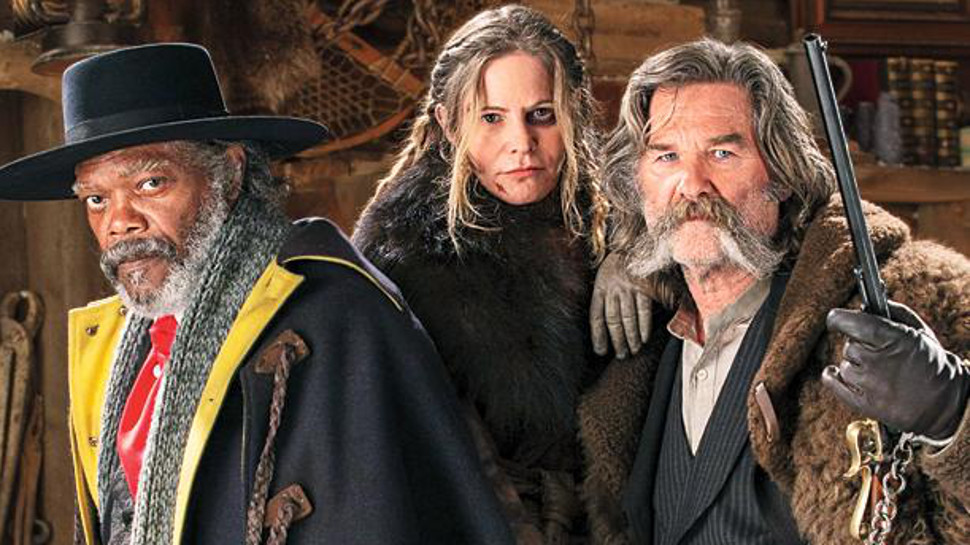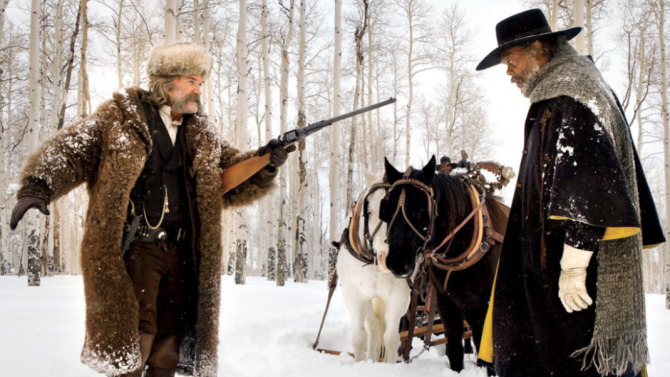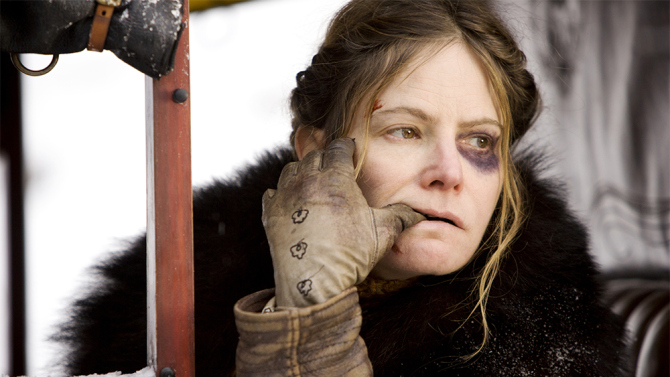
Note: This review contains no spoilers.
With his signature shrewd repartee and gleefully OTT violence, Quentin Tarantino’s latest film, The Hateful Eight, is a grisly and gratifying ensemble article that doubles as chamber piece.
Revisiting and reworking the Western genre for a second time, after 2012’s Django Unchained, Tarantino’s latest communiqué from the American frontier ensues in the years following the Civil War where race relations run reprehensible as eight rogues diverge together at Minnie’s Haberdashery – a stagecoach chalet in the Wyoming mountains – just as a blizzard touches down.
The ne’er-do-wells at Minnie’s include Samuel L. Jackson’s bounty hunter Major Marquis Warren, who’s in the middle of transporting three dead bodies, outlaws, to the town of Red Rock, where he intends to get compensation for their corpses. Warren has reluctantly and very temporarily teamed up with another bounty hunter, John Ruth (Kurt Russell), himself handcuffed to a battered and bruised Daisy Domergue (Jennifer Jason Leigh), a thwarted fugitive.
Also on the scene is Chris Mannix (Walton Goggins), also en route to Red Rock, with claims that he’s to be the new sheriff there, Sandy Smithers (Bruce Dern), a former Confederate General, Bob the Mexican (Demián Bichir), suspiciously claiming to be minding the haberdashery in Minnie’s absence, and Tarantino regulars Tim Roth and Michael Madsen as English hangman Oswaldo Mobray, and cheerless cowboy Joe Gage, respectively.
With every character keeping secrets and each with an itchy trigger finger, it’s apparent some of the “strangers” assembled at Minnie’s are in cahoots, awaiting an undisclosed time to break trust and draw blood.

At this point in the game, and The Hateful Eight marks Tarantino’s eighth feature film, audiences know what to expect from QT; fetishized wish-fulfillment violence, artfully staged, of course, pitch-dark comic relief, gratuitous and indiscriminate n-bombs dropped peremptorily, intricate plot developments that reveal themselves unexpectedly, linear time an option, not a maxim, and a jeering mise-en-scène certain to be dissected and redesigned.
It’s exciting and comically incisive that the first discernable thing about The Hateful Eight is that it’s shot in 70mm – a wide, uncommon, high-res format – and, after an opening salvo of John Ford-like panoramas of snow-flecked landscapes the story hunkers down into what is essentially a pocketed one-room chamber film.
That’s not to say that Tarantino eschews any visual flourish or frenzy, he just hems it in, packing perceptible cues and visible info in an interior space that heightens the girdled feel and the instilled panic of claustrophobia and cabin fever.
Also aiding and abetting this morality tale is a sullen and introspective score from the legendary Ennio Morricone, called out of retirement at Tarantino’s urging. It’s also a point of interest that several tracks used in the film were originally composed and arranged by Morricone to be used in John Carpenter’s winter set sci-fi classic The Thing, which was also a chamber film and also starred a cold-blooded Kurt Russell.
And in keeping with Tarantino’s designation of constructing killer OST’s for each of his films, choice cuts from Roy Orbison and the White Stripes add immeasurably to the equation.
The roadshow version of The Hateful Eight, which runs just over three hours long, and includes a musical overture introduction and an intermission, is something of a spectacle, and Tarantino chooses to tell his tale in six chapters, giving it a précis-like, recounted quality, which is further enforced by Tarantino’s own, non-flashy narration.
This storytelling fabrication mostly succeeds, except maybe that we know by now to expect some Rashomon-style revelations or some non-linear chronological epiphany, and so, taking that approach, The Hateful Eight does, to a degree, kneecap itself.
We know there’s more to what we’ve been shown after the first two chapters, and we know, because the opening titles have told us, that Channing Tatum will make an appearance (he does, as Daisy’s brother, Jody, and he gets to swagger and strut a little bit, too), and we know that we’re in the Tarantinoverse of artful explanations and retributions.

As juvenile and perverse as anything he’s done, Tarantino’s The Hateful Eight doesn’t shy away from scenes of horrible depravity, of repeated racist epithets, of brutal beatings repeatedly lashed out towards Daisy, and women by proxy, perhaps. But it also seems that misogyny and race relations are two big issues that have dogged at America’s uncultured heels for far too long.
Could this be at the crux of Tarantino’s overstated presentation? Of course it could be. Moral, personal, and political conduct have been revisited Tarantino themes since his debut, Reservoir Dogs, back in 1992. In fact, when you consider that much of the comedy and self-aggrandizing amusement that afflicts The Hateful Eight directly relates to misconstrued ideas of culture, be it race or gender, this may be one of the most subversive films of Tarantino’s tidy oeuvre.
This is the American Dream with any ideas of decorum and esteem set aside, the unseemly and anointed truth lays glistening, astonishingly exposed, betrayed by the truth-tellers and foul-mouthed raconteurs.
The patchy and uneven charms of The Hateful Eight extols and guilts not just Americana, namely the Wild West genre, it also underlines and observes the disparity of film. It plants you, the viewer, on well-acquainted soil – the upstanding bounty hunter, the conflicted lawman, the prisoner beyond recall – and emphasizes why we go to the cinema to begin with.
As digression, and distraction, abstraction, and celebration. The Hateful Eight is custom built for cinephiles and film lovers, for people who prefer the late night luster of a glittering bijou and the unbroken conversations movies provoke.
Taste of Cinema Rating: 4 stars (out of 5)
Author Bio: Shane Scott-Travis is a film critic, screenwriter, comic book author/illustrator and cineaste. Currently residing in Vancouver, Canada, Shane can often be found at the cinema, the dog park, or off in a corner someplace, paraphrasing Groucho Marx. Follow Shane on Twitter @ShaneScottravis.